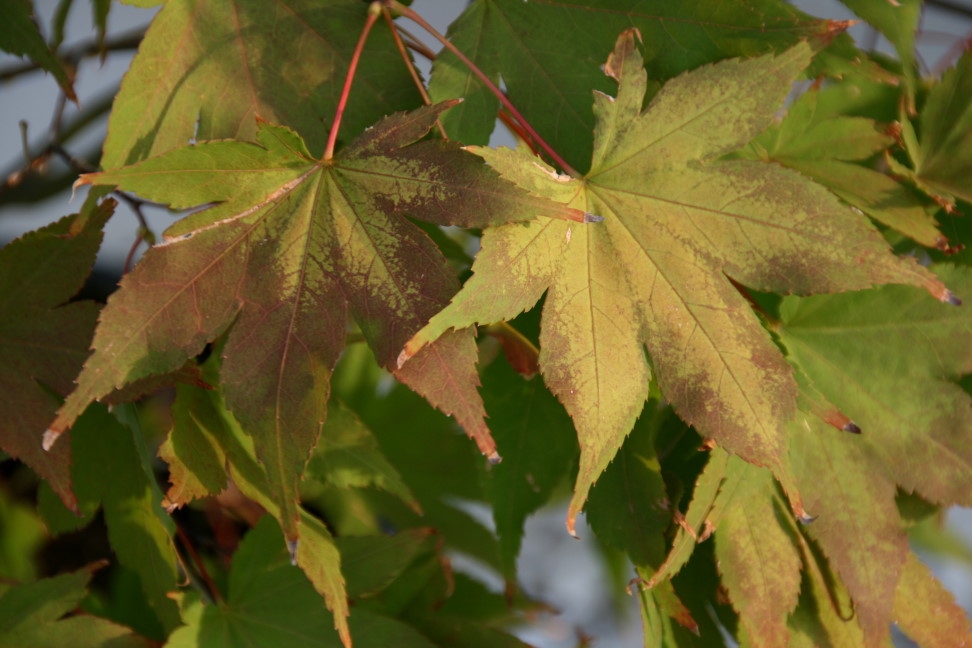Actually this concerns all A.p. Amoenum cultivars. But I have picked out Ōmato as representative of this group and one I especially like.
All Palmatums are designated into sun categories by leaf shape ( actually there are other parts to this as in size of leaf and fruit and how serrated the leaf is but i think mainly the leaf node depth is the determining factor) …basically how divided the nodes are from the base of leaf. These sub-types designated by leaf nodes are “dissectums”, “Matsumurae”, “Amoenum”, “Palmatum”, “Linearilobum” and “Other” ( “other”not like any of the aforementioned leaf shapes such as the cultivars Mama and Koshimino). In addition Vertrees has added “dwarf” to this mess which in my mind makes little sense other than keeping them separated in an illogical way. This is confusing to say the least. Not only is one sub group called “Palmatum” like the species, but the difference ( to me ) is really hard to tell especially between leaves of Palmatum and Matsumurae and to a lesser degree some Amoenums and even some Linearilobums ( which with too much fertilizer or at a young age of leaves are more Matsumurae”ish”) To cap it off being dwarf has nothing to do with leaf shape or any other quality except size of tree. If this last paragraph doesn’t confuse you well you are “special”.
But on the other side of this ID debacle thankfully many Amoenums are usually as obvious to the eye as Dissectums. Amoenums are the largest leafs with very little seperation in leaf nodes.
The reality of these JM’s with their unique but larger leaves is that most are ignored by most folks with few exceptions.
Like most things in life most folks have a predisposed ideas on just about everything … and of what they “think” a JM should look like is no exception. Most folks like RED ( green JM’s are much harder to sell in general with few exceptions). Most always “red’ frillier ( dissected- dissectum/lace/cut leaf) or more”separated” leave shape like most Bloodgood type uprights.
As a side note to these preferences and stereotyped mind sets. As sexist as this sounds, in general more women like dissectums than men (who like upright traditional less frilly ( more manly ;>) leaf shapes). I often laugh to myself how stand-off’ish and closed minded many men are towards dissectums as well as both genders are to beautiful green cultivars. Similarly most folks, men and women, just past right by the Amoenums like they are just “Eh” not “real JM’s or at least NOT their “idea of what a JM should look like.. Amoenums are large leaved and not typically what most have seen or read about. They are the just not what most folks have set in their minds when thinking about buying or growing a JM.
I have so many JM’s I personally like that are truly different, But the reality is the vast majority are similar in many ways and only subtly different to the eye of a true JM’ster ( IE addict) .. Thus I find the Amoenum leaf shape both pleasing and a good way to add variety in my collection as a group of cultivars that stands out, and that is not in the usual subtle way, only recognizable to us “addicts:”I just find them very cool and special.
Here is a late Aug full sun photo of an Ōmato

Ōmato comes out yellow green in spring …then turns green with a bronze shade ( depending on how much sun it gets) in summer and then a nice bright red in fall. It has good sun resistance and is very cold hardy. As with all JM’s it does NOT like wet feet. Size depends on your location .. in northern areas i would say 12+ft in many years but in more JM friendly areas it is a large tree.
Check out the Ōmato and other Amoenums and you will find some really cool cultivars that are not just like what most others have.
